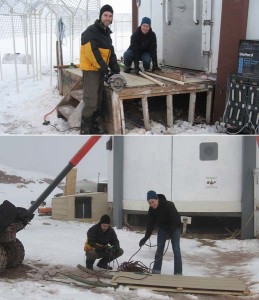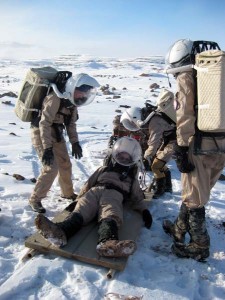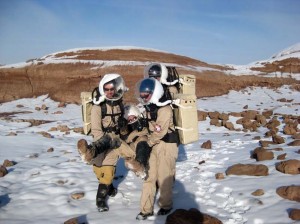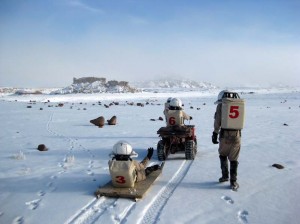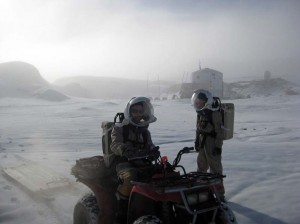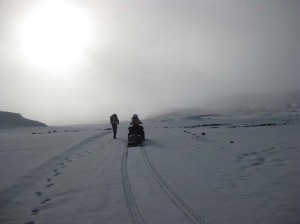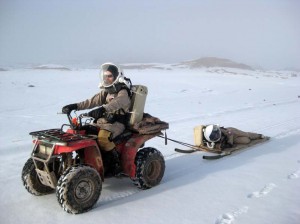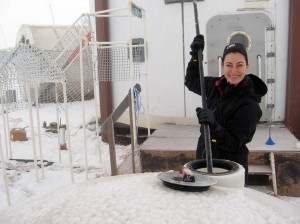While out on an EVA today, Darrel broke his leg. He had someone with him, of course—in this case, Mike—who was able to radio back to the Hab about the accident and request emergency assistance. Brian, Carla, and Kiri quickly suited up, and Luis remained behind to serve as HabCom and monitor our progress via radio. Twenty-one minutes later, we were exiting the airlock and on our way to rescue our downed crew member.
Lest the reader be overly anxious at this point, I should explain that Darrel didn’t really break his leg. We had decided to test our ability to respond to an emergency in which one crew member was unable to move. Carla and Brian spent the morning constructing a sled that could be used to drag someone back to the Hab behind an ATV. When the emergency call came in at 3:04 p.m., we all leapt into action. I plugged the coordinates that Mike reported into my GPS unit (fumbling a bit as I hadn’t ever tried to enter coordinates manually before—lesson learned!). We suited up in record time (13 minutes). Outside, Brian attached the sled to the Viking-1 ATV and kicked it into gear. Carla and I trailed along in his wake, on foot.We had stepped out into a snowy, misty world, where visibility was limited to about a quarter-mile. The sun lit up the fog, shedding silvery light all around us, and the hills were white mounds with patches of red peeking through on the south-facing slopes. Crunching along on the snowy road, we could see that we needed to head northeast to reach Mike and Darrel. The road would be more convenient for the sled, but their footprints led off to the north and we wanted to be sure we could reach them. So we headed off over the lumpy snow. (Our out-of-sim concerns about avoiding off-road ATV use were allayed by the thick layer of snow.) Viking-1 performed heroically, and the sled slid along behind in fine form.
We walked and walked, hoping with each rise that we’d suddenly see Mike and Darrel. But each time we were only rewarded with new views of their twin footprints, leading us onward. Finally, at 3:45 p.m. and about half a mile from the Hab, we crested a larger hill and discovered our fallen comrade, attended by Mike. We couldn’t get the ATV up to the foot of the rocky cliff where he’d “fallen”, so we lifted and carried him down to the ATV and sled. At that point we discovered that we were only about 40 yards from Lowell Highway, so after strapping Darrel to the sled, we continued on to the highway. Turning onto the snow-covered, graded road, we were able to make better time. We were back to the Hab by 4:35 p.m., at which point Darrel was again carried up into the airlock and, after depressurization, Luis was able to attend to his injuries.
A video of the rescue operation is in the works!
Another notable achievement for the day: Darrel and Luis put Viking-2’s carburetor back together and installed it, but so far no luck in starting the ATV. We’ll keep trying.
In the evening, we assembled for our second group exercise session. This time, Luis was our instructor and taught us basic capoeira moves—and wowed us with his advanced spinning and kicking! We all got a good workout (and no doubt entertained any webcam watchers). Now we’re busily filing reports and anticipating a tasty AlpineAir meal: Leonardo da Fettuccine.
